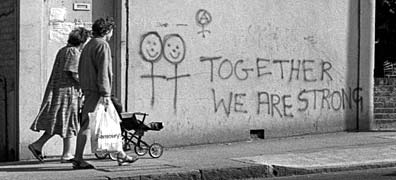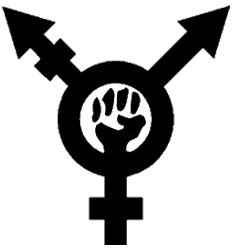By J. Rogue
(Full article available at Runagate Rampant)
Transfeminism developed out of a critique of the mainstream and radical feminist movements. The feminist movement has a history of internal hierarchies. There are many examples of women of color, working class women, lesbians and others speaking out against the tendency of the white, affluent- dominated women’s movement to silence them and overlook their needs. Instead of honoring these marginalized voices, the mainstream feminist movement has prioritized struggling for rights primarily in the interests of white affluent women. While the feminist movement as a whole has not resolved these hierarchal tendencies, various groups have continued to speak up regarding their own marginalization – in particular, transgendered women. The process of developing a broader understanding of systems of oppression and how they interact has advanced feminism and is key to building on the theory of anarchist feminism.
Transfeminism builds on the work that came out of the multiracial feminist movement, and in particular, the work of Black feminists. Frequently, when confronted with allegations of racism, classism, or homophobia, the women’s movement dismisses these issues as divisive. The more prominent voices promote the idea of a homogenous “universal female experience,” which, as it is based on commonality between women, theoretically promotes a sense of sisterhood. In reality, it means pruning the definition of “woman” and trying to fit all women into a mold reflecting the dominant demographic of the women’s movement: white, affluent, heterosexual, and non-disabled. This “policing” of identity, whether conscious or not, reinforces systems of oppression and exploitation. When women who do not fit this mold have challenged it, they have frequently been accused of being divisive and disloyal to the sisterhood. The hierarchy of womanhood created by the women’s movement reflects, in many ways, the dominant culture of racism, capitalism and heteronormativity.
 Mainstream feminist organizing frequently tries to find the common ground shared by women, and therefore focuses on what the most vocal members decide are “women’s issues” – as if the female experience existed in vacuum outside of other forms of oppression and exploitation. However, using an intersectional approach to analyzing and organizing around oppression, as advocated by multiracial feminism and transfeminism, we can discuss these differences rather than dismiss them. The multiracial feminist movement developed this approach, which argues that one cannot address the position of women without also addressing their class, race, sexuality, ability, and all other aspects of their identity and experiences. Forms of oppression and exploitation do not exist separately. They are intimately related and reinforce each other, and so trying to address them singly (i.e. “sexism” divorced from racism, capitalism, etc) does not lead to a clear understanding of the patriarchal system. This is in accordance with the anarchist view that we must fight all forms of hierarchy, oppression, and exploitation simultaneously; abolishing capitalism and the state does not ensure that white supremacy and patriarchy will be somehow magically dismantled.
Mainstream feminist organizing frequently tries to find the common ground shared by women, and therefore focuses on what the most vocal members decide are “women’s issues” – as if the female experience existed in vacuum outside of other forms of oppression and exploitation. However, using an intersectional approach to analyzing and organizing around oppression, as advocated by multiracial feminism and transfeminism, we can discuss these differences rather than dismiss them. The multiracial feminist movement developed this approach, which argues that one cannot address the position of women without also addressing their class, race, sexuality, ability, and all other aspects of their identity and experiences. Forms of oppression and exploitation do not exist separately. They are intimately related and reinforce each other, and so trying to address them singly (i.e. “sexism” divorced from racism, capitalism, etc) does not lead to a clear understanding of the patriarchal system. This is in accordance with the anarchist view that we must fight all forms of hierarchy, oppression, and exploitation simultaneously; abolishing capitalism and the state does not ensure that white supremacy and patriarchy will be somehow magically dismantled.
Tied to this assumption of a “universal female experience” is the idea that if a woman surrounds herself with those that embody that “universal” woman, then she is safe from patriarchy and oppression. The concept of “women’s safe spaces” (being women-only) date back to the early lesbian feminist movement, which was largely comprised of white, middle-class women who prioritized addressing sexism over other forms of oppression. This notion that an all-women space is inherently safe not only discounts the intimate violence that can occur between women, but also ignores or de-prioritizes the other types of violence that women can experience; racism, poverty, incarceration and other forms of state, economic and social brutality.
 The Transfeminist Manifesto states: “Transfeminism believes that we construct our own gender identities based on what feels genuine, comfortable and sincere to us as we live and relate to others within given social and cultural constraint. (1)”
The Transfeminist Manifesto states: “Transfeminism believes that we construct our own gender identities based on what feels genuine, comfortable and sincere to us as we live and relate to others within given social and cultural constraint. (1)”
The concepts espoused by transfeminism help us understand gender, but there needs to be an incorporation of transfeminist principles into broad based movements. Even gay and lesbian movements have a history of leaving trans people behind. For example, the Employment Non-Discrimination Act does not protect gender identity. Again we see a hierarchy of importance; the gay and lesbian movement compromises (throwing trans folks under the bus), rather than employing an inclusive strategy for liberation. There is frequently a sense of a “scarcity of liberation” within reformist social movements, the feeling that the possibilities for freedom are so limited that we must fight against other marginalized groups for a piece of the pie. This is in direct opposition to the concept of intersectionality, since it often requires people to betray one aspect of their identity in order to politically prioritize another. How can a person be expected to engage in a fight against gender oppression if it ignores or worsens their racial oppression? Where does one aspect of their identity and experiences end and another begin? Anarchism offers a possible society in which liberation is anything but scarce. It provides a theoretical framework that calls for an end to all hierarchies, and, as stated by Martha Ackelsberg, “It offers a perspective on the nature and process of social revolutionary transformation (e.g. the insistence that means must be consistent with ends, and that economic issues are critical, but not the only source of hierarchal power relations) that can be extremely valuable to/ for women’s emancipation. (2)”
Notes
1. The Transfeminist Manifesto by Emi Koyama (2000)
2. Lessons from the Free Women of Spain an interview with Martha Ackelsberg by Geert Dhont (2004)
